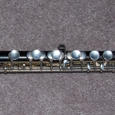One of the keys to successful piccolo performance is treating the instrument as a serious part of your daily practice ritual. Many people do not practice piccolo consistently and wonder why they have trouble. The first thing you can do to improve your piccolo playing is commit to daily practice for about 30 minutes. You will always be in shape and able to handle the various physical demands of the instrument when you train your body on a daily basis.
There are four key concepts for piccolo players that differ quite a bit from flute playing: use of air, embouchure/aperture, hand placement, and use of alternate fingerings
Air
Because the piccolo is so much smaller, (and has a smaller bore than the flute as well) tone production is based on good support and fast moving air but not a large quantity of air. Many novice piccolo players use too much air, which results in a harsh, loud, over-blown brassy tone with faulty intonation.
Daily long tones that begin in the middle register will help train your body to get used to the different air useage requirements. I love the simple warm up at the beginning of Patricia Morris’ Piccolo Study Book (Novello), which is based on triadic passages. Keep your tuner handy so you can work on intonation as well as tone quality. In my experience this is a great way to multi-task in the practice room.
Remember that you are also training your body to remember the new feeling of using slightly less air on the piccolo. It is a different skill and requires a separate muscle memory. I would spend 15 minutes a day on long tones throughout all three registers. (Similar to a 30 Minute Ab Workout, this is a very concentrated kind of practice that gives half of your time to tone and intonation). Of course when you have additional time to practice, you should spend a greater amount of time on tone studies.
Embouchure/Aperture
Place the piccolo slightly higher on the lower lip than you do when placing the flute: this compensates for the normal-size lips we bring to a miniature- size blow hole. The piccolo is theoretically too small for the size of our lips; moving the piccolo higher on the lower lip helps us play within the limits of this compromise.
Keep reminding yourself to remain firm in the embouchure, but never tight. A common mistake players make is pinching in order to downsize the aperture. Remember to exaggerate the pout of a flute embouchure by moving slightly more forward with the lips, almost as if you were blowing a kiss to somebody across the room. The embouchure never produces the tone: tone is produced by the airstream. Your lips are only directing the air to the back wall or striking point on the blow hole.
Align the piccolo’s headjoint by lining up the embouchure hole slightly in front of the key centers, rather than in the center of them. This may also help you achieve more clarity in your sound because the embouchure will be more relaxed and you will be unable to cover too much of the hole by accident. If you are producing a most glorious tone with perfect intonation, then you are probably using a great embouchure already.
Hands
Since our hands are so much closer together on the piccolo, make sure that you are not adding extra tension in either the hands, shoulders, neck, or arms. It helps to remember to balance the piccolo between your left knuckle joint and right thumb, as opposed to holding the instrument. Keep the fingers as close to the keys as possible as this diminishes excess finger motion and increases efficiency of technique.
I find that practicing trills is an excellent way to work on light, quick, low finger motion. It is impossible to raise your fingers too high off the keys when executing a quick trill. The trill exercise in Taffanel & Gaubert’s 17 Big Daily Exercises is an excellent specific study.
Because of the piccolo’s small size, I find it tempting to raise my right shoulder slightly when playing. Be sure to keep that shoulder in its proper relaxed position, lower than you might think. Don’t allow it to make friends with your earlobe!
For this compressed practice schedule, I recommend 10 minutes of technical practice – either an etude (there are many fabulous sources to choose from) or daily study of patterned scales from the Taffanel & Gaubert or Moyse books.
Alternate Fingerings
Lastly, I find that knowledge of alternate fingerings is a wonderful technique specific to the piccolo. I use alternates in my flute playing as well, but they are different fingerings than those I use on the piccolo. Also, the piccolo’s problem notes are slightly different from the flute’s. I use more alternates on flute to lower pitch at a louder dynamic. Alternates on piccolo help me most when I am playing extremely softly.
Spending a few minutes each day working on fingering options for some of the more unstable notes on your instrument will save you a lot of headaches down the road. I often use several different choices available for the same pitch depending on the dynamic, the color I want, and who I am blending with in a chord. Knowing the tendencies of the alternates makes me ready for any given situation.
With just a little time each day, this routine will quickly make you a stronger piccolo player.






